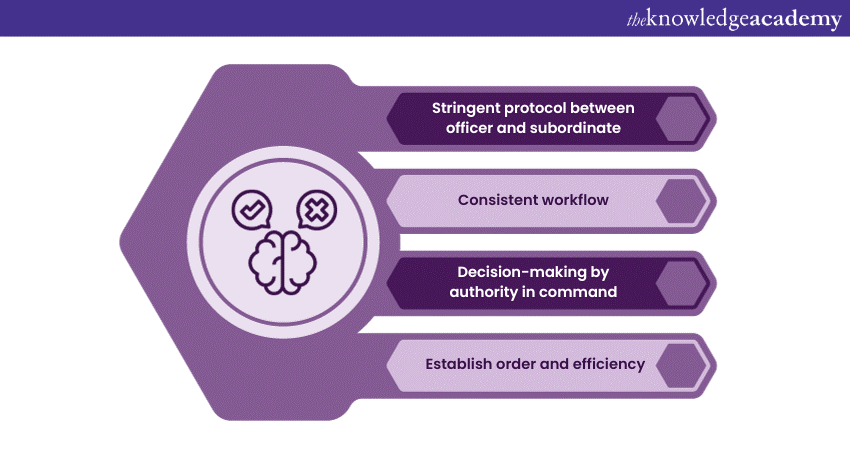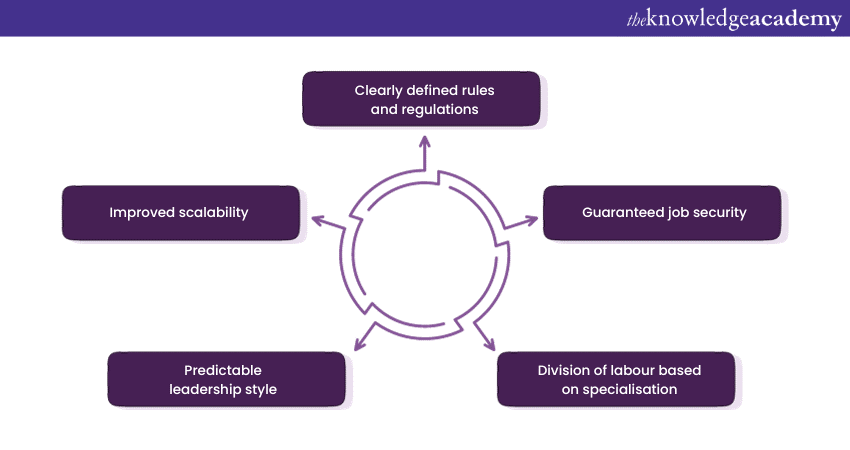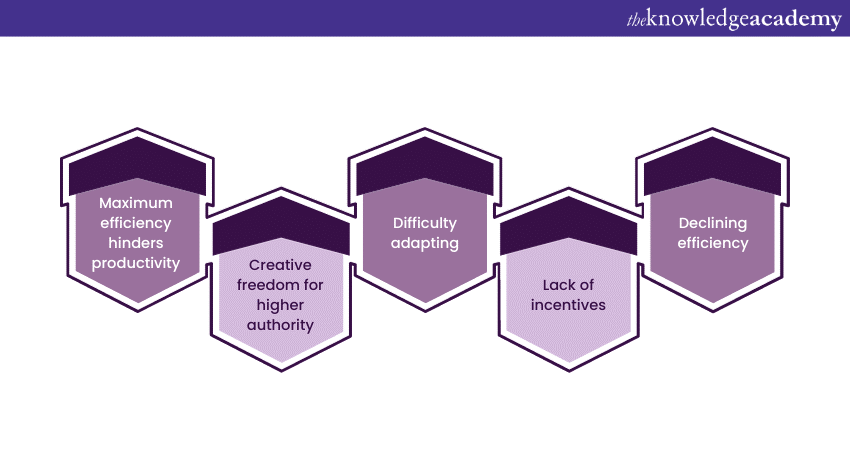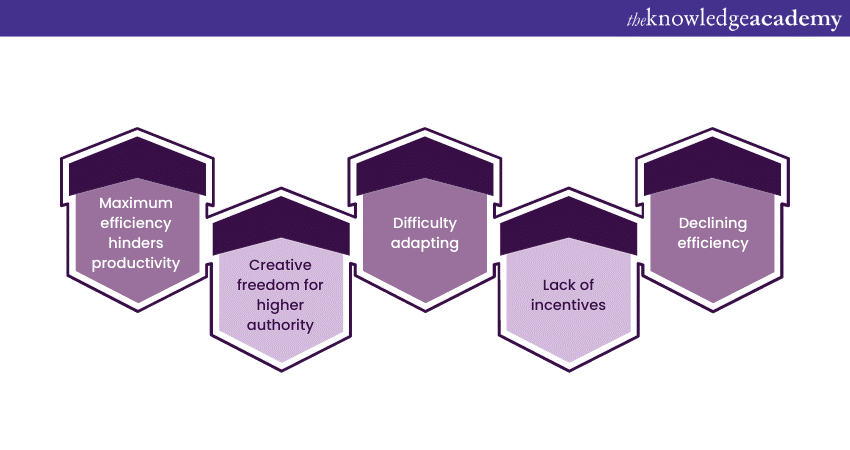We may not have the course you’re looking for. If you enquire or give us a call on 01344203999 and speak to our training experts, we may still be able to help with your training requirements.
Training Outcomes Within Your Budget!
We ensure quality, budget-alignment, and timely delivery by our expert instructors.

Leadership is a dynamic and essential aspect of any successful organisation, driving the ship through the unpredictable seas of challenges and opportunities. But not all Leadership styles can fit your organisational goals. One of these styles that stands out from the rest is Bureaucratic Leadership. But before implementing it in the organisational environment, it’s crucial to learn – What is Bureaucratic Leadership. So, understand the intricacies of this type of Leadership and bring disciple to your organisational work culture. Read this blog to explore What is Bureaucratic Leadership. Also, explore its key characteristics, advantages and disadvantages and more.
Table of Contents
1) Understanding What is Bureaucratic Leadership
2) Exploring the characteristics of Bureaucratic Leadership
3) The skills required to be a Bureaucratic Leader
4) Advantages of Bureaucratic Leadership
5) Disadvantages of Bureaucratic Leadership
6) Key examples of Bureaucratic Leadership
7) Conclusion
Understanding What is Bureaucratic Leadership
Bureaucratic Leadership is a style of Leadership that entails that the leader abides by a comprehensive chain of command, strictly instituted regulations and conformity of their followers.
The definition of Bureaucratic Leadership may come across as off-putting at first glance. However, many governing organisations have benefited from this framework of Leadership. Leadership systems of a Bureaucratic structure can be of significant advantage for businesses that pivot on the framework of efficient management.
Now, if you backtrack to the meaning of bureaucracy itself, it is the appointment of a team of individuals who are selected after a tedious, thorough process. These appointed individuals are responsible for handling official matters and executing the orders of business, including laws, rules and policies.
This demonstrates some stellar attributes of bureaucracy, such as professionalism, stringent hierarchy of command, selective authority, assigned responsibilities and rules for decision-making. These qualities make the Bureaucratic Leadership style more disciplined and structured.
Exploring the characteristics of Bureaucratic Leadership
Now that you have learnt What is Bureaucratic Leadership, it’s time to learn about its key characteristics. Maximillian Karl Emil Weber, the founding father of Bureaucratic Leadership, German Sociologist, Historian, Jurist and Political Economist, has a strong hold over the defining factors of Bureaucratic Leadership. Max was confident about the positive impact of this Leadership style in any organisation.
Additionally, he also envisioned the transformation of businesses into large factories and massive establishments. He then devised the following characteristics of Bureaucratic Leadership:
Decision-making hierarchies

The hierarchical structure is the defining characteristic of Bureaucratic Leadership. The stringent protocol between officers and their subordinates of various departments forms the firm and robust backbone of the hierarchy. This structure maintains consistency in the workflow throughout the system. More importantly, the authority in command of the bureaucracy hands down the decision-making schedule, which helps establish order and efficiency in a business establishment.
Transactional relationships
Bureaucratic relationships in an organisation always remain transactional because they help employees from various departments to maintain a healthy balance between professional relationships and their personal lives. Transactional relationships are essentially based on mutual benefit and needs between two individuals.
Both individuals have certain expectations that they want the other to fulfil, during which they typically exchange some service or support. Any human emotions such as love, compatibility or chemistry are generally out of the equation of a transactional relationship.
In a Bureaucratic management system, professionals typically depend on their colleagues or other professionals to accomplish tasks before they can proceed to new ones. For example, if professional ‘X’ has an expectation that professional ‘Y’ can fulfil, ‘Y’ may agree to help ‘X’ on the condition of a barter-based system where each helps the other with a favour.
These relationships entail that professional ‘X’ has to finish the task for ‘Y’ before ‘Y’ can finish the task for ‘X’. This translates to a more transactional than personal nature of the relationship between X and Y, which helps improve the understanding of their responsibilities in an organisation.
Role-based specialisations
Seasoned and experienced individuals can accomplish only certain responsibilities in a Bureaucratic management system. This means that the Bureaucratic Leadership style official appoints only those individuals who are best suited for the position in the organisation. The employees of any department must be equipped with a comprehensive understanding and expertise in the subject.
Well defined responsibilities
Every employee in a Bureaucratic-styled organisational structure is obligated to abide by certain rules and protocols. Bureaucratic leaders generally assign responsibilities to their subordinates along with a framework for performing their daily activities. This ensures that they hold a good understanding of their stature and keeps them in the know-how about their job functions.
Professionalism
A Bureaucratic Leadership style maintains a high level of professionalism with a practice of impartial decision-making. It is because it believes in not favouring any one individual over the other, which is one of the pillars of its organisational status.
Enhance your Leadership abilities, by signing up for our Leadership Skills Course now!
The skills required to be a Bureaucratic Leader
A system that functions on a Bureaucratic system of management generally appoints its leader panel only after an extensive examination and evaluation of their attributes, their experience with positions of authority and professionalism. This type of Leadership requires a properly defined skill set to fulfil the job role’s responsibilities. Here is a list highlighting the key skills required for an individual to be deemed the right fit for a Bureaucratic leader’s post:
Technical expertise

Technical expertise is one of the most important prerequisites for a candidate to fill a Bureaucratic position. This skill helps the leader demonstrate their constructive approaches to managing others.
Any officer who leads a bureaucracy needs to possess a firm, robust, and dedicated personality that acknowledges their field prowess. For example, the Vice President of a large establishment is given the responsibility of managing a research team. The responsibility entails that they have the technical know-how of the software clubbed with a background in management.
A Bureaucratic leader needs to understand how to perform certain roles and tasks to the best of their abilities if they are well-versed with the knowledge and skills required for their designated domain. After acquiring the foundational level of expertise, employees can then enhance their performance through the repetitive structure of the job.
Determination and willpower
A Bureaucratic system generally requires leaders who possess and demonstrate persistence in their willpower while executing their duties. The institution’s work structure demands an extremely professional and ethical code of conduct. Such leaders are expected to have a high tolerance towards adverse conditions, a mind of steel, excellent decision-making abilities and a strong presence of mind.
Hardworking nature

The Bureaucratic style of Leadership is deemed to be the toughest of all styles because it requires consistent hard work and an authoritative tone of voice and presence. The officers and their subordinates in a Bureaucratic relationship need to foster and maintain a positive outlook toward work. Moreover, leaders need to devise new delegation strategies and ensure that their subordinates are applying their skills to ensure optimal efficiency.
Learn to make important decisions by signing up for our Decision-Making Skills Training now!
Advantages of Bureaucratic Leadership
Here is a list highlighting the various advantages of Bureaucratic Leadership:

a) Clearly defined roles, expectations and responsibilities: The Bureaucratic Leadership style institutes a set of rules and regulations that make up the whole protocol for all positions in the organisation.
b) Job security: Bureaucratic job profiles always entail the responsibility of the individual to comply with the set guidelines. If they abide by all the rules and deliver optimal performance, they have a high chance of a lustrous future in their career.
c) Division of labour: Bureaucratic Leadership style systems appoint a qualified official to an assigned role according to their specific expertise so they can perform their tasks properly.
d) Encouragement of creativity: Bureaucratic management styles encourage and promote new and innovative ideas and strategies that enable effortless management. However, the space for creativity and innovation only lies in the hands of higher authority.
e) Predictable Leadership styles: Bureaucratic Leadership style concentrates on the behaviour of their consumers and drives a strong result-centric approach. Thus, there are no margins for errors because of its predictable structure.
f) History of previous glories: Looking back at previous projects that helped the organisation achieve success is what helps a Bureaucratic organisation continue their victories in a smooth and inexpensive manner.
g) Improves scalability: Bureaucratic systems implement a multitude of solutions for increasing the size of the organisation. Scalability also pushes for upward growth among organisations in the industry.
Disadvantages of Bureaucratic Leadership
Akin to other styles of Leadership, there are also some key disadvantages of Bureaucratic Leadership that pivot on the regulation and implementation of Bureaucratic duties. These disadvantages also translate to the lack of a Bureaucratic official’s growth in their careers. So, let’s have a quick look at them:

a) Maximum efficiency can be problematic: Bureaucratically structured management systems blossom with maximum efficiency. However, a very stringent set of responsibilities toughens the employees’ efforts to be more productive.
b) Creative freedom only for higher authority: Since only the higher Bureaucratic authorities are allowed to practice creativity and innovation, individuals at subordinate levels are left with routine administrative tasks. This, in turn, prevents their imaginative freedom at the workplace.
c) Difficulty adapting to change: Bureaucratic officials find it difficult to adapt themselves to organisational change. This is largely due to the fact that they are accustomed to a discipline of routine without any room for flexibility, which changes happen slowly.
d) Lack of encouragement towards personal growth: Individuals employed in Bureaucratic systems of management generally do not succeed in attaining their desired level of personal development. This happens because they direct most of their efforts towards achieving the common goal in the business.
e) Inefficiency due to change of command: Employees find it difficult to devise new strategies to tackle problems due to the presence of the decision-making hierarchy.
f) Lack of incentives: Bureaucratic systems do not reward their employees with incentives for good performance, which does not push them enough to work harder.
g) Downfall in efficiency: Bureaucratic Leadership systems tend to hinder growth especially in small-sized organisations and any budding companies.
Learn the techniques to effectively handle a team by signing up for our Introduction to Supervising a Team Course now!
Key Examples of Bureaucratic Leadership
Here is a list of important examples that are a great representation of Bureaucratic Leadership:
Winston Churchill
Winston Leonard Spencer Churchill was a statesman, soldier and writer who served as the Prime Minister of the United Kingdom twice in the Second World War. After his service in the army, he acquired experience in managing a country in times of war.
Additionally, Winston Churchill followed a goal-oriented approach where his subordinate officials understood the structure and their responsibilities. Moreover, his style of delegating authority faced significant critique, putting him in the middle of controversies. However, his critics soon discovered it was futile to persuade a leader as firm as him, making him one of the greatest leaders of all time.
Sinjo Sogo of the Japanese National Railways
Another great example of a Bureaucratic leader is Sinjo Sogo, the fourth President of the Japanese National Railways. His Leadership style helped the country go through a revolution in its railway networks.
Sogo emphasised modernising specialisations at the workplace. He especially instituted a robust set of regulations and protocols that helped the country accomplish the most revolutionary Engineering masterpiece in the history of innovation.
Steve Easterbrook of McDonald’s
A food establishment as massive and globally spread out as McDonald’s has a foundation in Bureaucratic Leadership style. He instituted a rule that all employees of the business abided by the authority’s orders.
He also made a rule that employees will be involved in negligible decision-making and maximum productivity. These measures have translated and demonstrated the establishment’s consistent performance across its international outlets
Conclusion
We hope that you have now understood the concept of What is Bureaucratic Leadership. An organisation has a higher chance of achieving business success from a Bureaucratic form of management. This Leadership style is pivotal to authority and a hierarchical chain of command, along with a robust set of regulations and protocols to be followed by all employees. Moreover, such a management system ensures maximum levels of efficiency and productivity at the workplace.
Attain the necessary skills to lead any team by signing up for our Leadership Training now!
Frequently Asked Questions
Upcoming Business Skills Resources Batches & Dates
Date
 Leadership Skills Training
Leadership Skills Training
Fri 31st May 2024
Fri 28th Jun 2024
Fri 26th Jul 2024
Fri 30th Aug 2024
Fri 27th Sep 2024
Fri 25th Oct 2024
Fri 29th Nov 2024
Fri 27th Dec 2024







 Top Rated Course
Top Rated Course



 If you wish to make any changes to your course, please
If you wish to make any changes to your course, please


